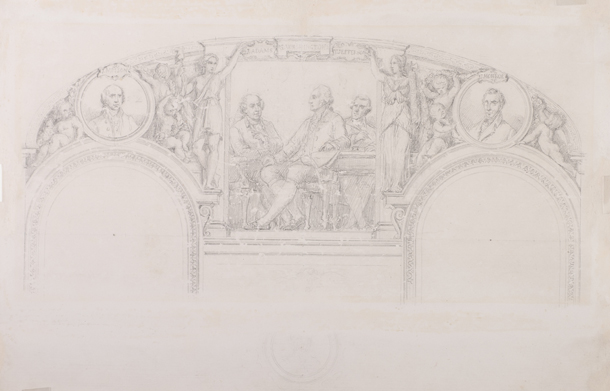
| Title | Sketch, Washington, Adams, Jefferson |
| Artist/Maker | Constantino Brumidi (1805 -1880) |
| Date | 1870 ca. |
| Medium | Pencil on paper |
| Dimensions | h. 10.43 x w. 15.75 in. (h. 26.51 x w. 40 cm) |
| Credit Line | U.S. Senate Collection |
| Accession Number | 37.00097.000 |
This finely rendered drawing is one of the few extant pencil sketches by Constantino Brumidi. It shows the artist’s proposed mural for the south wall in the Senate Reception Room of the U.S. Capitol. The scaled drawing also illustrates the proposed mural in relation to the room’s architecture, such as the arched lunette and doors. The paper is pierced with five small pinholes, the result of the artist’s tool for drafting circular forms.
When Brumidi executed the pencil sketch around 1870, he intended to portray U.S. presidents throughout the Senate Reception Room’s murals. The pencil drawing depicts portraits of six presidents. The central scene shows George Washington, John Adams, and Thomas Jefferson seated together. The nation’s first three presidents are flanked at either side by portrait rondels of the fourth and fifth presidents, James Madison and James Monroe. A portrait rondel of Ulysses S. Grant, who served in office as the 18th president when Brumidi drew the sketch, appears faintly rendered at the bottom of the drawing.
After submitting the pencil sketch to Architect of the Capitol Edward Clark for approval, Brumidi was asked to revise the central scene to illustrate President Washington in consultation with two of his cabinet advisors, Secretary of State Thomas Jefferson and Treasury Secretary Alexander Hamilton. It is possible that this directive was related to the Senate’s passage—over Andrew Johnson’s presidential veto—of the Tenure of Office Act, designed to limit the president’s ability to shape his cabinet by requiring that dismissals, as well as appointments, be approved by the Senate. Johnson's violation of the Tenure of Office Act was a primary charge against the president in the 1868 impeachment trial.
Brumidi’s commissions at the Capitol were frequently interrupted to accommodate the needs of a busy, public building. In 1870, Brumidi painted the classical figures and trompe l’oeil designs from the pencil sketch onto the south wall of the Senate Reception Room. In 1874, he added the central scene to the mural. However, Brumidi was never assigned to paint any of the presidents’ portraits from the pencil sketch in the room’s rondels, despite his petition in 1876 to complete his plans for the space. The Senate Reception Room rondels remained blank at the time of the artist’s death in 1880.
At age 13, Constantino Brumidi entered Rome's prestigious Accademia di San Luca and spent 14 years studying drawing, painting, and sculpture. He earned important commissions and awards during his career in Italy in the 1830s and 1840s. When Brumidi immigrated to America in 1852, his rigorous academic training and professional experience gave him a distinct advantage: Brumidi was one of the few artists in the United States who was skilled at designing murals for large, complex spaces and who was proficient at painting in fresco, a challenging but traditional medium that was desired for the murals at the U.S. Capitol.
In keeping with the practices of his academic training, Brumidi often prepared meticulous, detailed sketches to scale in pencil as one of the preliminary steps to creating a mural. Brumidi would then work up preparatory studies, typically in oil on canvas, of the proposed scenes. The preparatory studies would be submitted for review to officials in charge of the decoration of the Capitol.
Once the proposed mural in a preparatory study was approved, Brumidi would enlarge the scene from the study to a full scale rendering on oversize paper, traditionally called a cartoon. The outlines of the images could then be transferred from the cartoon onto the wall or ceiling. Brumidi used the details worked out in the studies–such as coloring or shading–as his guide when executing a mural. Many of the preparatory studies for Brumidi's work in the Senate wing of the Capitol are in the Senate collection.